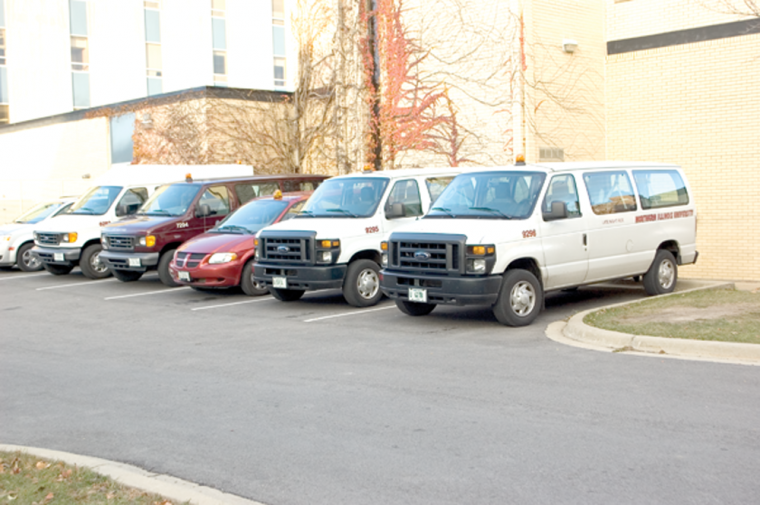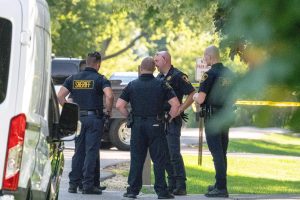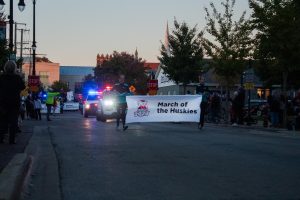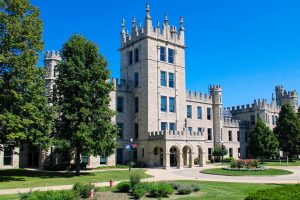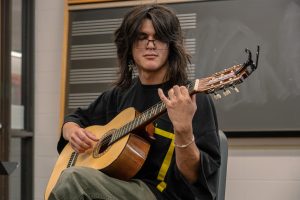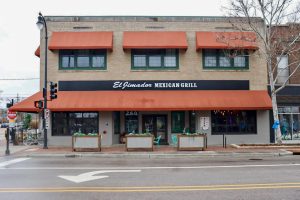NIU Late Night Ride Service has been everywhere in DeKalb
The Late Night Ride vans are parked outside of the NIU Police headquarters. Many people in the community use the free service to go all over the DeKalb area.
February 11, 2011
DeKALB | “It’s kind of like a taxi cab,” said an NIU student about the Late Night Ride Service. The LNRS vans will take anyone anywhere, no questions asked, free of charge.
A caller only needs to provide their name, location and desired destination, number of riders and a phone number when requesting a ride from the service.
Sgt. Alan Smith of the NIU Police disagrees with senior biology major Catherine Kist that the Late Night Ride operates like taxi service.
Smith said the purpose is community service.
“It’s about getting our students and the NIU community where they need to go safely,” he said. “I know a lot of people refer to it as the ‘drunk bus,’ but that’s not what it’s about.”
Rides are offered no-questions-asked so as not to discourage ridership.
“We don’t care where we’re picking [people] up or where we’re taking them to,” Smith said. “That’s their business. We just want to get them there safely.”
Anyone, but not anytime
Smith said the rides are offered to the entire NIU community, which includes non-NIU students and DeKalb residents.
Kist said she thinks the Late Night Ride should only be for NIU students.
“We paid for it,” Kist said.
Junior communications major Dave Daum said he doesn’t have a problem with DeKalb residents using the service.
“I think it’s great,” he said. “Sometimes people need to get places and don’t have cars.”
Sophomore psychology major Beatrice Cross said she thinks that one of the reasons the wait to be picked up by LNRS can be long might be because community members can use it. She said students should get priority.
Cross said she waits for an average of an hour to get from Northern View or Stevenson Towers to Lincoln Hall at 10 or 11 p.m. She said, in one instance, she waited for over three hours.
The biggest complaint the LNRS receives is that the wait time is too long, Smith said.
Smith said the last time he measured statistics on wait time was late October or early November. He found the average wait time to be 12 to 13 minutes.
But a lot of factors influence delays, he said.
Calls come into two phones at the police department, Smith said, and they receive as many as 200 calls in a half hour. Ride requests are put into a queue and then relayed by dispatchers to drivers in one of the five vans, which may be travelling anywhere across the DeKalb area. Though riders are called when the van is on its way to their location, many riders don’t pick up or are not waiting outside when it arrives. It takes more time for the driver to call the rider again and wait for them to come outside.
In November, the Northern Star filed a Freedom of Information Act to Joan Laurino, deputy FOIA officer for NIU, for daily logs tracking every stop made by the Late Night Ride vans from Oct. 14 to Nov. 11. On Nov. 24 the Northern Star received two PDF files containing 84 pages dating from 6:30 p.m. Nov. 6 to midnight on Nov. 11.
The log showed that 13 percent of 992 rides had phone connection problems. Most problems were riders not picking up their phone and the driver leaving a voice mail, but other issues mentioned were “no voice mail,” “can’t call,” and “hung up.”
Smith said sometimes riders never show for the ride but fail to call the Late Night Ride to cancel their request. Vans wait up to 10 minutes before leaving for the next destination, Smith said. These riderless drives delay rides for others in the queue even further.
Smith asks riders to be patient.
“We’re not just catering to you. There are other people we have to pick up,” he said. “We try to get people to understand that.”
But the Late Night Ride can cater to people if they call in advance.
Riders can schedule rides in advance, Smith said, but not many take advantage of it. The LNRS dispatch starts accepting calls starting at 4 p.m. People can reserve a time to be picked up later that night.
Junior pre-nursing major Martika Mitchell said she scheduled a ride by reservation and didn’t have to wait at all. She said the driver called her to say the van was a little early.
Smith said Thursday, Friday and Saturday nights between midnight and 3 a.m. used to be the busiest times for the service, when its hours of operation were 10 p.m. to 6 a.m.
“Now, it’s just nonstop,” Smith said, “It’s all day.”
The service extended its hours to 4 p.m. to 8 a.m. on Oct. 26 to accommodate students’ safety concerns after the disappearance of NIU student Antinette “Toni” Keller.
Other security measures enacted at that time were done away with at the beginning of this semester. The extended Late Night Ride hours have stayed.
Smith said NIU Police have kept the extended hours because student demand for them is high.
“People got used to it,” he said, “Once you do certain things people start expecting [them].”
NIU Police have no plans to return to the original hours of operation, Smith said, at least not until this semester ends.
Door-to-door
Smith said the LNRS is constantly busy now because students are “taking it everywhere.”
Students often take the vans from residence halls to other residence halls, from residence halls and off-campus residences and vice versa.
Smith said people use the LNRS because they find the buses too crowded or prefer the door-to-door service so they don’t have to walk from a bus stop to their destination.
He said he feels people taking the Late Night Ride for these reasons are using the service for its intended purpose as a safety measure.
“It’s all about perception,” he said. “If students feel safer, then it’s working.”
Sophomore finance major Jordan Near said he calls the Late Night Ride on weekends to avoid walking in the cold and to “stay safe.”
“On weekends [and] late nights you don’t want to go out there,” Near said. “With drunk drivers, with what happened earlier in the semester, it’s just a safe feeling [to have the Late Night Ride].”
But Smith said he realizes some people might not take the LNR for any reason other than to get somewhere.
“[For] most people, I think it’s not a safety issue,” Smith said. “They just want a ride from one place to another place. And that’s what we do.”
One of those students unworried about safety is Daum, who said he’s not afraid of walking alone.
“It’s just good that [the LNRS] is there,” he said. “People should take advantage of those opportunities.”
Free of charge
The Late Night Ride Service is an opportunity for people to get door-to-door transportation, free of charge.
Another transportation resource at NIU, the Huskie Bus Line, doesn’t provide personal service, but caters to many locations around the NIU campus and DeKalb residences and businesses.
The Huskie Bus Line, however, unlike the Late Night Ride, charges a fare of 75 cents for non-students. This fare will increase to $1 on Feb. 15.
Both the Huskie Bus Line and Late Night Ride are free of charge to NIU students.
During peak travel times, 17 buses travel on eight routes. Most of the buses operate from 7 a.m. to 7 p.m. Night service for the Huskie Bus is available from 7 p.m. to midnight on four routes. The Huskie Bus Line also offers weekend routes, said Josh Venaas, Student Association chief of staff and former director of mass transit.
Smith said he would encourage people to use the buses, but the LNRS will not deny riders service based on where they want to go.
Venaas said he understands that sometime students need to get places that the Huskie Bus Line doesn’t service, but he encourages students to choose to take the bus if they can.
“The Late Night Ride Service is always busy…so if you can take the bus system to free up space on the Late Night Ride for other people, that’s ultimately the best and that’s what we want for the students,” he said. The number seven bus line runs to several businesses in DeKalb, businesses that the Late Night Ride also frequents.
The log showed that between Nov. 6 and Nov. 11, LNRS vans made 180 stops at Jewel, White Castle, Walmart, the YMCA, Target, Burger King and Kishwaukee comunity Hospital, stops that the number seven bus also services.
Out of those 180 stops, 79 percent were made during the operating hours of the seven bus.
The seven bus routes operate two buses that make rounds every half hour.
Wait times for the other bus routes are usually about 10 to 15 minutes, Venaas said.
Daum said he doesn’t really mind if people take the Late Night Ride to locations they could access with the Huskie Bus Line, depending on how far away their destination is.
“It’s just a van.” Daum said. “It’s not like…that’s burning tons and tons of fossil fuel. It’s not the biggest deal in the world.”
But the Late Night Ride Service vans are burning more fuel than last year.
Last semester, from Sept. 1 to Dec. 31, the vehicle expenses and fuel for the LNRS cost about $26,000. A 65 percent increase from $15,000 the year before, said Eddie Williams, executive vice president for Business and Finance and chief of operations, in an e-mail interview.
Mileage increased 81 percent from about 30,000 miles during fall 2009 to about 55,000 miles for fall 2010, Williams said. That was about an 81 percent increase.
With the implementation of the extended hours last semester, the total hours of operation doubled. The extended hours were not implemented until Oct. 24, more than halfway through the semester.
The total budget of the LNRS was $320,000 during the 2010-2011 school year. That budget will increase this year due to the extended operating hours, Williams said.
Anywhere
The log showed riders took the Late Night Ride to off-campus businesses more often than they took it to those locations during normal operating hours.
The total number of hours the Late Night Ride Service operates doubled with the extended hours. In the log, the number of locations visited during only the extended hours, from 4 p.m. to 10 p.m. and 6 a.m. to 8 a.m., account for about 52 percent of the total locations. The other 48 percent of locations were visited during the former normal operating hours, from 10 p.m. to 6 a.m.
Though stops during the extended hours accounted for about half of total stops, visits to off-campus businesses accounted for 65 percent of total off-campus stops.
Rides to or from DeKalb area schools and clothing stores occurred solely during the extended hours. Trips to or from grocery stores or entertainment locations like movie theaters occurred 82 percent of the time during the extended hours. Trips to or from department stores accounted for 66 percent. Fast food and non-bar restaurants accounted for 67 percent.
Smith said one of the most frequented locations by the Late Night Ride is Walmart.
Stops at WalMart accounted for about 6 percent of all stops made by the Late Night Ride vans in the log, the highest of all off-campus business stops.
Riders went to Walmart 72 times and were picked up from there 45 times.
Kist said she doesn’t care about students taking the LNRS to shop.
“It’s annoying taking groceries on the bus,” said junior biology major Bethany Hernandez.
Cross said the she thinks the bus, rather than the LNRS, is meant for shopping purposes.
“[Shopping is] something you don’t necessarily have to do,” she said “I know you might need stuff, but it’s not a necessity.”
No Questions Asked
On Nov. 7, the LNRS made three trips to 1215 Blackhawk Drive, the location that previously housed bars Reilly’s and Tequila Roadhouse.
The Northern Star reported in a Jan. 27 article about the alleged parties that took place at the location, though there is little evidence of them.
According to the log, a trip was made by a LNR van from a residence on Ridge Drive to “Tequila Roadhouse” at 12:12 a.m. Vans also drove from Grant Towers South to “Club Exposure” at 1:41 a.m. and at 1:49 a.m.
All entries in the log were in the DeKalb or Sycamore area except for two trips of about 18 miles that were made to the Metra station in Elburn, from residence halls.
Smith said the NIU Police does not want to leave students stranded at the Elburn station if they have no means of getting back to campus.
The Huskie Bus Line runs a shuttle to Elburn on Fridays and Sundays, but does not allow passengers to board without a ticket purchased in advance.
On Nov. 7, the Late Night Ride Service drove from Neptune North to Elburn at 11:39 a.m, The earliest the Elburn shuttle leaves the student center is 3:25 p.m., arriving at the station at 4:15 p.m.
A LNRS van drove from the Elburn Train station to Lincoln Hall at 6:42 p.m. on Nov. 10, which was not during the operation of the Elburn shuttle.
Smith said the LNRS service will only go out to Elburn in “rare circumstances,” and only if the LNRS isn’t busy.
“We don’t publicize that…because then we’ll get everybody wanting a ride to the train station, wanting a ride back, and that’s not what [the LNRS] is for,” Smith said.
Some riders use the service for shorter distances.
Smith said students take the LNRS from Grant Towers to the Rec center, one of the shortest drives it makes.
Students may find themselves taking the Late Night Ride without requesting a ride in special circumstances.
If a student is arrested in a residence hall, the Late Night Ride Service may give them a ride home from the NIU Police Station, Smith said. The LNRS may also pick up a student from the residence hall if they can bring bond money for a friend.
The Late Night Ride officially operates from 4 p.m. to 8 a.m., but in the log, 13 out of the 992 rides occurred outside of that time frame.
Smith said the NIU Police sometimes use the vans for other police business.
Last Resort
The LNRS has “regulars,” customers who use the service frequently or call the LNR to take them to the same location at the same time everyday, Smith said.
During breaks, the Late Night Ride Service runs on its normal hours of operation from 10 p.m. to 6 a.m.
“We still have students and community people that rely on us to get them places [during breaks],” Smith said.
But he also said people shouldn’t rely on the Late Night Ride.
“We advocate people calling in advance, having a backup, not just relying on us as their sole transportation,” Smith said.
Venaas also said students should not rely on the service. Students should plan ahead when they need to get somewhere by checking the bus schedules or seeing if they can get a ride.
Mitchell said she thinks people too often take the LNRS for “pointless” reasons.
“The Late Night Ride should be your last resort,” she said. “Don’t call just anytime for anything.”


